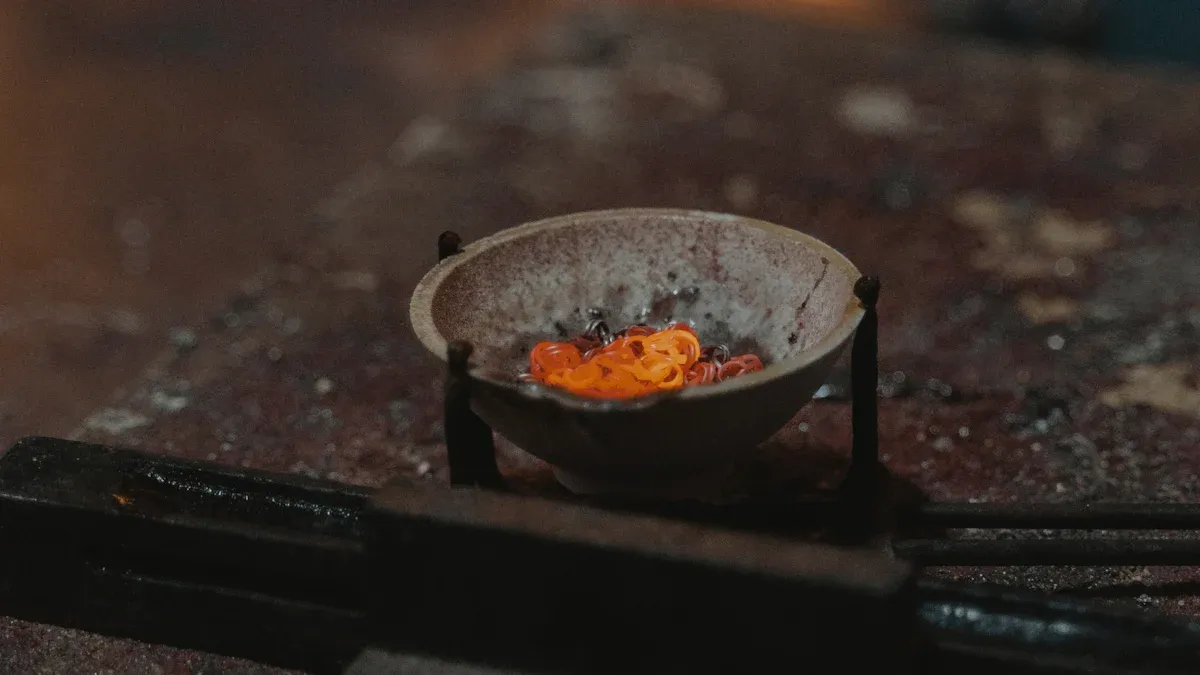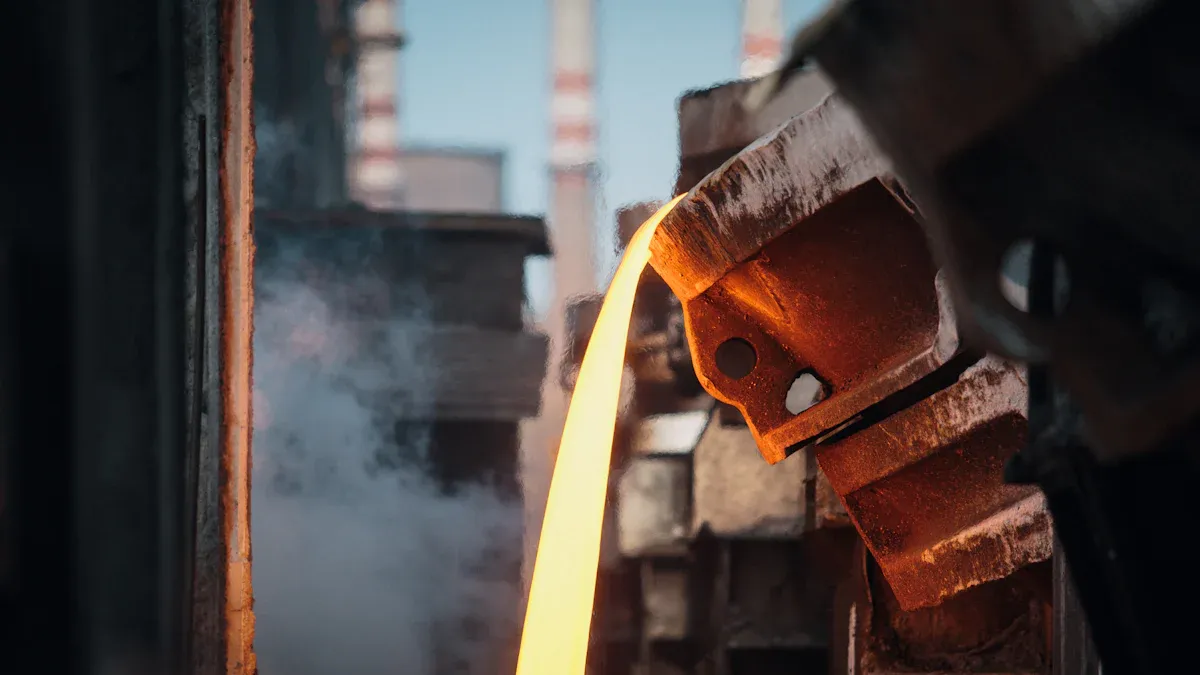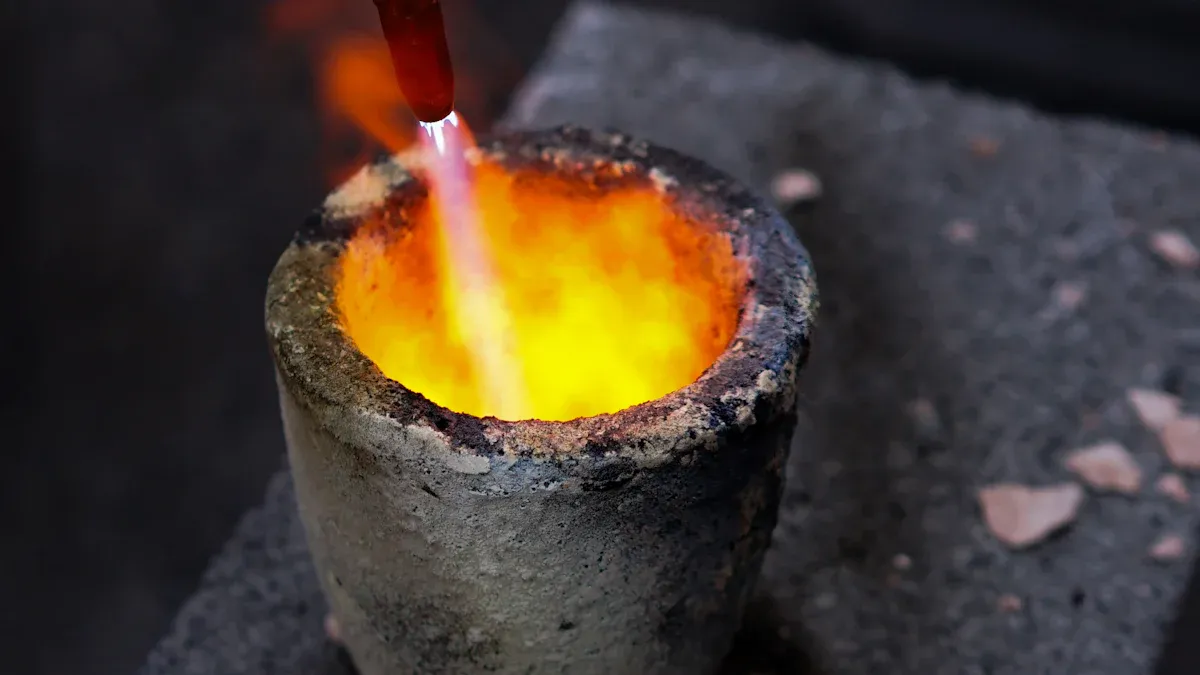How To Choose The Right Investment Casting Material?

Choosing the right investment casting materialis essential for achieving optimal performance and cost efficiency. Investment Precision Castings, utilizing materials like stainless steel, tin bronze, and silicon brass, offer unique properties tailored to various applications. For example, the global market forprecision investment, valued at USD 18.16 billion in 2023, is expected to grow at a 5.36% CAGR, driven by the increasing demand for lightweight and durable materials in industries such as aerospace and automotive. This underscores the importance of selecting materials that provide the perfect balance of strength, durability, and cost. Advanced processes like lost wax casting depend heavily on this critical decision to ensure superior quality and efficiency.
Did you know? Material selection plays a significant role in cost management, with unit prices ranging from $10 to $25 based on complexity and material.
Key Point:
Choosing the right Investment Casting material ensures enhanced performance, cost savings, and suitability for specific applications.
Key Takeaways
- Picking the right material for casting improves quality and saves money.
- Stainless steel is durable and rust-proof, good for harsh conditions.
- Tin bronze resists wear, making it great for cars and boats.
Overview of Investment Precision Castings
What is investment casting?
Investment casting, also known as lost wax casting, is a manufacturing process that creates precise and complex metal components. It begins with a wax model, which is coated in ceramic to form a mold. After the wax is melted away, molten metal is poured into the mold to replicate the original design. This method is widely used for its ability to produce intricate shapes with excellent surface finishes and minimal material waste.
The process is highly versatile, accommodating a variety of metals and alloys. Industries such as aerospace, automotive, and medical rely on investment casting for its precision and efficiency. With a projected market growth of 4.58% CAGR by 2031, this technique continues to gain popularity in modern manufacturing.
Key Point: Investment casting is ideal for producing detailed and high-quality metal parts across various industries.
Common materials used in investment casting
Investment casting supports a wide range of materials, each offering unique properties for specific applications. Below is a table summarizing some of the most common materials:
| Material | Properties | Common Applications |
|---|---|---|
| Stainless Steel | Corrosion resistance, high strength, durability | Aerospace, medical, food processing |
| Carbon Steel | Durability, machinability, cost-effective | Auto parts, construction, heavy machinery |
| Alloy Steel | Enhanced strength, toughness, wear resistance | Oil and gas, mining, defense industries |
| Aluminum | Lightweight, corrosion-resistant | Aerospace, automotive, consumer electronics |
| Brass and Bronze | Attractive appearance, good conductivity | Decorative and electrical applications |
Stainless steel, tin bronze, and silicon brass are particularly popular in Investment Precision Castings due to their durability and versatility. These materials meet the demands of industries like power generation, shipbuilding, and engineering machinery.
Key Point: The choice of material depends on the desired properties and application, with stainless steel, tin bronze, and silicon brass being top choices for precision casting.
Stainless Steel in Investment Precision Castings

Properties of stainless steel (304, 316)
Stainless steel, particularly grades 304 and 316, is a popular choice in investment precision castings due to its exceptional mechanical and thermal properties. These grades offer high tensile strength, with 304 ranging from 520 to 750 MPa and 316 from 500 to 680 MPa. Their yield strength is equally impressive, with 304 at 215 MPa and 316 at 290 MPa. Additionally, both grades exhibit excellent hardness, with 304 at 70 B and 316 at 79 B.
Temperature resistance is another standout feature. Grade 304 can withstand temperatures from 425°C to 860°C, while 316 performs well up to 843°C. These properties make stainless steel a reliable material for demanding applications requiring durability and heat resistance.
Key Point: Stainless steel’s strength, hardness, and temperature resistance make it ideal for precision casting in challenging environments.
Applications of stainless steel in precision castings
Stainless steel is widely used in industries where precision and durability are critical. For instance, aerospace and automotive sectors rely on stainless steel investment castings for components that demand high strength and corrosion resistance. In the medical field, stainless steel is essential for surgical instruments and implants due to its biocompatibility and ease of sterilization.
Other notable applications include:
- Transitioning from brass lost-wax casting to stainless steel for enhanced precision and reduced waste.
- Producing ultralight racing bicycle components using advanced techniques like metal binder jetting, which improves performance and reduces costs.
Key Point: Stainless steel’s versatility supports its use in aerospace, automotive, medical, and even sports industries.
Advantages and limitations of stainless steel
Stainless steel offers numerous advantages in investment precision castings. Its excellent corrosion resistance reduces maintenance costs and ensures long-term durability. The material’s high strength and toughness make it suitable for demanding applications, while its easy-to-clean surface enhances productivity. Economically, stainless steel can lower total ownership costs by 30-40% compared to alternatives, thanks to reduced corrosion-related expenses.
However, stainless steel does come with higher initial costs and specialized production requirements, which can increase expenses. Despite these challenges, its long-term benefits often outweigh the upfront investment.
| Aspect | Details |
|---|---|
| Advantages | - Excellent corrosion resistance, reducing maintenance costs. |
| - Long-term savings due to durability and lower life-cycle costs. | |
| - Easy to clean, enhancing productivity and reducing downtime. | |
| - High strength and toughness, suitable for demanding applications. | |
| Limitations | - Higher initial costs compared to some alternative materials. |
| - Specialized production processes can increase expenses. | |
| Economic Benefits | - Total cost of ownership can be 30-40% lower than alternatives due to reduced corrosion costs. |
| - Significant annual costs due to corrosion can be mitigated by using stainless steel. |
Key Point: While stainless steel may have higher upfront costs, its durability and cost-effectiveness make it a smart long-term investment.
Tin Bronze in Investment Precision Castings

Properties of tin bronze
Tin bronze is a copper-based alloy that contains tin as its primary alloying element. This composition enhances its strength, hardness, and corrosion resistance, making it a reliable choice for demanding environments. The typical composition includes 86-88.5% copper, 9.3-10.5% tin, and small amounts of zinc and lead. Its physical properties include a tensile strength of 304 MPa and a yield strength of 140 MPa, ensuring excellent mechanical performance. Additionally, its thermal conductivity of 59 W/mK allows it to perform well in applications requiring heat dissipation.

Key Point: Tin bronze’s unique composition and properties make it ideal for precision casting in challenging environments.
Applications of tin bronze in precision castings
Tin bronze is widely used in Investment Precision Castings due to its excellent casting properties and ability to create intricate designs. In the automotive industry, it is commonly used for bearings and bushings because of its high mechanical strength and wear resistance. The marine sector relies on tin bronze for ship propellers, rudders, and fittings in saline environments, as it resists seawater corrosion and reduces maintenance needs. Aerospace applications include gears and bushings, where strength and precision are critical.
| Industry | Application | Reason for Use |
|---|---|---|
| Automotive | Bearings and bushings | High mechanical strength and excellent wear resistance |
| Marine | Ship propellers and rudders | Resists seawater corrosion, reducing maintenance needs |
| Marine | Fittings in saline environments | Ensures durability and reliability in harsh conditions |
| Aerospace | Gears and bushings | Strength and precision are critical in high-performance sectors |
Key Point: Tin bronze’s versatility supports its use in automotive, marine, and aerospace industries.
Advantages and limitations of tin bronze
Tin bronze offers several advantages in precision casting. Its high strength and wear resistance make it suitable for components under heavy loads, such as gears and bearings. The material’s excellent corrosion resistance ensures durability in harsh environments, including marine and industrial settings. Additionally, its low friction properties improve efficiency and reduce maintenance costs.
| Aspect | Details |
|---|---|
| Advantages | - High strength and wear resistance for heavy-duty applications. |
| - Excellent corrosion resistance, especially in marine environments. | |
| - Low friction properties, reducing maintenance costs. | |
| Limitations | - Higher material cost compared to some alternatives. |
| - Limited availability in certain regions. |
Key Point: Tin bronze combines strength, corrosion resistance, and low friction, making it a valuable material for precision casting.
Silicon Brass in Investment Precision Castings
Properties of silicon brass
Silicon brass is a copper alloy that combines copper, zinc, and a small percentage of silicon. This unique composition enhances its strength, corrosion resistance, and machinability. It typically contains 1-3% silicon, which improves its wear resistance and reduces the risk of dezincification—a common issue in traditional brass alloys. Silicon brass also offers excellent thermal and electrical conductivity, making it a versatile material for various industries. Its tensile strength ranges from 350 to 550 MPa, ensuring durability in demanding applications.
Key Point: Silicon brass stands out for its strength, corrosion resistance, and ability to maintain performance in harsh environments.
Applications of silicon brass in precision castings
Silicon brass is a popular choice in Investment Precision Castings due to its versatility and reliability. In the plumbing industry, it is used for valves, fittings, and faucets because of its resistance to corrosion and dezincification. The marine sector relies on silicon brass for components like propellers and pump housings, as it withstands saltwater exposure. Additionally, it finds applications in electrical connectors and terminals, thanks to its excellent conductivity and durability.
| Industry | Application | Reason for Use |
|---|---|---|
| Plumbing | Valves, fittings, faucets | Corrosion resistance and long-lasting performance |
| Marine | Propellers, pump housings | Withstands saltwater exposure |
| Electrical | Connectors, terminals | High conductivity and durability |
Key Point: Silicon brass is widely used in plumbing, marine, and electrical industries for its reliability and performance.
Advantages and limitations of silicon brass
Silicon brass offers several advantages in precision casting. Its corrosion resistance ensures durability in harsh environments, while its high strength and wear resistance make it suitable for heavy-duty applications. The material’s excellent machinability allows for the production of intricate designs with ease. However, silicon brass may have a slightly higher cost compared to standard brass alloys, which could impact its use in cost-sensitive projects.
| Aspect | Details |
|---|---|
| Advantages | - High corrosion resistance |
| - Excellent strength and wear resistance | |
| - Good machinability for complex designs | |
| Limitations | - Slightly higher cost than standard brass |
Key Point: Silicon brass combines strength, corrosion resistance, and machinability, making it a top choice for precision casting.
Comparative Analysis of Casting Materials
Material properties comparison
Each material used in Investment Precision Castings offers unique properties that cater to specific needs. Stainless steel, known for its exceptional corrosion resistance and strength, performs well in harsh environments. Tin bronze, with its high wear resistance and low friction, excels in heavy-duty applications like bearings and bushings. Silicon brass stands out for its machinability and resistance to dezincification, making it ideal for plumbing and marine components.
| Material | Key Properties | Best Features |
|---|---|---|
| Stainless Steel | High strength, corrosion resistance | Durable in extreme conditions |
| Tin Bronze | Wear resistance, low friction | Ideal for heavy loads |
| Silicon Brass | Machinability, dezincification resistance | Reliable in plumbing and marine settings |
Key Point: The choice of material depends on the required properties, such as strength, corrosion resistance, or machinability.
Cost-effectiveness of stainless steel, tin bronze, and silicon brass
Cost plays a crucial role in material selection. Stainless steel has a higher upfront cost but offers long-term savings due to its durability and low maintenance. Tin bronze, while slightly more expensive, provides excellent performance in demanding applications, reducing replacement costs. Silicon brass, though pricier than standard brass, delivers superior reliability and longevity, especially in corrosive environments.
| Material | Initial Cost | Long-term Value |
|---|---|---|
| Stainless Steel | High | Low maintenance, durable |
| Tin Bronze | Moderate | Reduces replacement costs |
| Silicon Brass | Moderate-High | Reliable in harsh environments |
Key Point: While initial costs vary, long-term value often justifies the investment in these materials.
Best material for specific applications
Selecting the best material depends on performance, cost, and sustainability. Stainless steel suits industries like aerospace and medical, where strength and corrosion resistance are critical. Tin bronze is perfect for automotive and marine applications requiring wear resistance. Silicon brass works well in plumbing and electrical sectors due to its machinability and conductivity.
| Criteria | Data Sources |
|---|---|
| Performance | Expert opinions, literature reviews, modeling exercises |
| Cost | Varies based on the decision problem and resources available |
| Sustainability | Combination of quantitative and qualitative data |
Key Point: Matching material properties to application needs ensures optimal performance and cost-efficiency.
Choosing the right material for Investment Precision Castings is crucial for achieving optimal performance and cost savings. Stainless steel offers unmatched corrosion resistance and strength, making it ideal for harsh environments. Tin bronze excels in wear resistance and durability, perfect for heavy-duty applications. Silicon brass combines machinability and corrosion resistance, making it a reliable choice for plumbing and marine components.
When selecting materials, consider specific needs:
- For chloride-rich environments, 316 stainless steel is a better option due to its molybdenum content.
- For less aggressive conditions, 304 stainless steel provides a cost-effective solution.
- Tin bronze and silicon brass are excellent for applications requiring low friction or resistance to dezincification.
A cost-benefit analysis helps balance initial expenses with long-term savings. Stainless steel, for instance, reduces maintenance costs and offers up to 40% savings in total ownership costs compared to alternatives.
Key Point: Match material properties to application requirements for the best results in performance and cost-efficiency.
FAQ
What industries benefit the most from investment casting?
Industries like aerospace, automotive, marine, and medical benefit greatly. Investment casting provides precision, durability, and cost-efficiency for complex components in these sectors.
Key Point: Investment casting supports industries requiring high-quality, intricate metal parts.
How do I choose the right material for my application?
Consider factors like strength, corrosion resistance, and cost. Match the material's properties to your specific application needs for the best results.
Key Point: Material selection depends on balancing performance and budget.
Is investment casting environmentally friendly?
Yes, it minimizes material waste and supports sustainable practices. Recyclable materials like stainless steel and bronze further enhance its eco-friendliness.
Key Point: Investment casting aligns with sustainability goals through reduced waste and recyclable materials.















